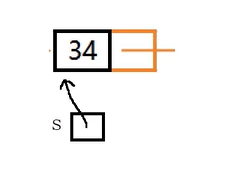方法一:三个指针

定义三个指针
pre(前驱指针)
初始化成NULL,
s初始化成NULL
,
p指向第一个数据的地址
。
(1)pre=NULL,s=NULL,p//链表不为空或链表不止一个节点
(2)s=p;//s下移

(3)p=p->next; //p下移

(5) s->next=pre;//s的下一位为自己(s)的上一位,即ai指向ai+1

(4)pre=s;//pre指向s,pre下移

实现代码:
#include<stdio.h>
#include<stdlib.h>
#include<assert.h>
#include<string.h>
#include"My_LinkList.h"
void ReverseList(LinkList head)//空链表不用逆置
{
assert(head!=NULL);
if (head->next == NULL || head->next->next == NULL)//单链表为NULL或只有一个节点,不用逆置
{
return;//退出
}
ListNode * pre = NULL, * s = NULL;
ListNode* p = head->next;
while (p != NULL)
{
s = p;
p = p->next;
s->next = pre;//ai+1指向ai
pre = s;
}
head->next = pre;
}
int main()
{
LinkList head = InitList;
for (int i = 0; i < 10; i++)
{
Push_Back(head, i + 1);
}
PrintList(head);
ReverseList(head);
return 0;
}
方法二:两个指针(头插法)
(1)s=NULL,p;//p不为NULL,循环开始
(2)p!=NULL;
(3)s=p;//p,s同时指向首节点

(4)p=p->next;//p后移

(5)s->next=head->next;//头插,s指向首节点的next域,被置为空

(6)head->next=s;//s中存放的是含有23节点的首地址,head->next存放的也是23节点的首地址

循环继续
(2)p!=NULL;(2)p!=NULL;4)p=p->next;


(5)s->next=head->next;

(6)head->next=s;

最后效果;

实现代码:
#include<stdio.h>
#include<stdlib.h>
#include<assert.h>
#include<string.h>
#include"My_LinkList.h"
void ReverseList(LinkList head)//空链表不用逆置
{
assert(head!=NULL);
if (head->next == NULL || head->next->next == NULL)//单链表为NULL或只有一个节点,不用逆置
{
return;//退出
}
ListNode* s = NULL, * p = head->next;
head->next = NULL;
while (p != NULL)
{
s = p;
p = p->next;
s->next = head->next;
head->next = s;
}
}
int main()
{
LinkList head = InitList;
for (int i = 0; i < 10; i++)
{
Push_Back(head, i + 1);
}
PrintList(head);
ReverseList(head);
return 0;
}
方法三:栈(用栈的先进后出,单链表数据全部入栈之后,然后把带头结点的数据结点给p,数据出栈,然后覆盖原数据)
栈逆置方法1
图示:
数据入栈

数据出栈

实现代码:
#include<stdio.h>
#include<stdlib.h>
#include<assert.h>
#include<string.h>
#include"My_LinkList.h"
void ReverseList(LinkList head)//空链表不用逆置
{
assert(head != NULL);
if (head->next == NULL || head->next->next == NULL)//单链表为NULL或只有一个节点,不用逆置
{
return;//退出
}
int* stack = (int*)malloc(sizeof(int) * len);
int top = -1;//为模拟栈做准备
p = head->next;
while (p != NULL)//入栈
{
top += 1;
stack[top] = p->data;
p = p->next;
}
p = p->head->next;
while (p != NULL)//出栈
{
p->data = stack[top];
top = top - 1;
p = p->next;
}
free(stack);
stack = NULL:
}
int main()
{
LinkList head = InitList;
for (int i = 0; i < 10; i++)
{
Push_Back(head, i + 1);
}
PrintList(head);
ReverseList(head);
return 0;
}
栈逆置方法2:
#include<stdio.h>
#include<stdlib.h>
#include<assert.h>
#include<string.h>
#include"My_LinkList.h"
void ReverseList(LinkList head)//空链表不用逆置
{
assert(head != NULL);
if (head->next == NULL || head->next->next == NULL)//单链表为NULL或只有一个节点,不用逆置
{
return;//退出
}
int len = 0;
ListNode* p = head->next;
while (p != NULL)//O(n)
{
len++;
p = p->next;
}
int* stack = (int*)malloc(sizeof(int) * len);
int top = -1;
p = p->next;
}
p = head->next;
while (p != NULL)//O(n)
{
p->data = stack[top];
top = top - 1;
p = p->next;
}
free(stack);
stack = NULL;
}
int main()
{
LinkList head = InitList;
for (int i = 0; i < 10; i++)
{
Push_Back(head, i + 1);
}
PrintList(head);
ReverseList(head);
return 0;
}
方法四:递归
p->next->next=p;
p->next=NULL:
实现代码:
#include<stdio.h>
#include<stdlib.h>
#include<assert.h>
#include<string.h>
#include"My_LinkList.h"
ListNode* Reverse(ListNode* p)
{
if (p == NULL || p->next == NULL)
{
return p;
}
ListNode* firstnode = Reverse(p->next);
p->next - next = p;
p->next = NULL;
return firstnode;
}
void ReverseList(LinkList head)//空链表不用逆置
{
assert(head != NULL);
if (head->next == NULL || head->next->next == NULL)//单链表为NULL或只有一个节点,不用逆置
{
return;//退出
}
ListNode* p = head->next;
head->next = Reverse(p);
}
int main()
{
LinkList head = InitList;
for (int i = 0; i < 10; i++)
{
Push_Back(head, i + 1);
}
PrintList(head);
ReverseList(head);
return 0;
}